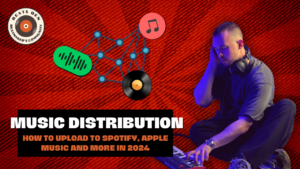When it comes to mixing music, one of the most important concepts to understand is gain staging. Put simply, gain staging is the process of setting the gain (or volume) levels of each element in a mix to ensure that they work together harmoniously and without distortion.
While it may sound like a straightforward task, it is actually a highly technical and nuanced process that requires a deep understanding of signal flow and processing. In this blog post, we’ll explore the basics of gain staging and why it’s so important in the mixing process.
The Basics Of Gain Staging
At its core, gain staging is all about balancing the levels of each element in a mix. This means adjusting the gain (or volume) of each instrument, vocal, or effect in a way that allows them to sit well together in the mix without overwhelming or distorting each other.
To understand it, it’s helpful to think of a mix as a series of stages, each of which contributes to the final sound. These stages might include individual tracks or channels in a DAW (Digital Audio Workstation), plugins or effects, a submix or bus, and the final stereo output.
You might learn how to export individual tracks for gain staging, also called STEMS, in this post!
At each stage, gain staging is crucial to ensure that the levels are consistent and balanced. For example, if one track is significantly louder than the others, it will likely overpower the rest of the mix and cause distortion. On the other hand, if one track is too quiet, it may get lost in the mix altogether.
It’s important to note that gain staging occurs at the beginning of the mixing process, before any processing with effects or mixer channels.

Why Gain Staging Matters
At this point, you might be wondering why gain staging is so important. After all, can’t you just adjust the volume levels by ear and call it a day?
While it’s true that you can rely on your ears to some extent, there are several reasons why gain staging is a critical part of the mixing process:
- Prevents distortion: When levels are too high at any stage of the mix, distortion can occur. This can lead to a harsh, unpleasant sound that detracts from the overall quality of the mix.
- Maximizes headroom: By keeping levels consistent and balanced, you can ensure that there is plenty of headroom available throughout the mix. This allows for greater dynamic range and a more natural, dynamic sound.
- Improves clarity: When levels are balanced, each element in the mix has its own space to breathe and be heard. This can lead to greater clarity and definition, making it easier for listeners to pick out individual instruments or vocals.
- Makes processing more effective: When levels are consistent, any processing or effects applied to the mix will be more effective. For example, a compressor will work more efficiently when levels are balanced, leading to a more polished, professional sound.

Tips for Effective Gain Staging
Now that you understand the basics of gain staging and why it matters, let’s explore some tips for effective gain staging in your own mixes:
- Start with a low-level mix: When you first start building a mix, keep all levels low and gradually build up the volume as you add more elements. This will help you avoid clipping or distortion from the outset.
- Use a reference track: A reference track can be a great tool for gain staging. Choose a professionally mixed track in a similar style to your own and use it as a benchmark for your own levels.
- Use meters: Meters, such as the peak or RMS meter in your DAW, can be helpful for keeping an eye on levels throughout the mix. Aim for consistent levels between -18 and -12 dBFS for each element in the mix. I’m using Brainworx Audio bx_meter.
- Pay attention to panning: Panning can affect perceived loudness, so it’s important to consider it in your staging. For example, a sound panned hard left may need to be slightly

Conclusion
We’ve learned about a fundamental process in mixing music that involves balancing the volume levels of each element in a mix to prevent distortion and improve clarity. By keeping levels consistent and using tools such as reference tracks and meters, you can maximize headroom, create a dynamic mix, and make processing more effective. Gain staging is a technical but essential aspect of the mixing process that can help you achieve a polished, professional sound.












